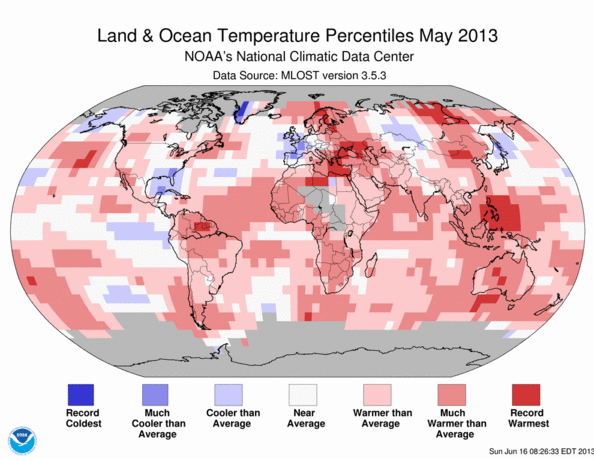May 2013 Earth’s 3rd Warmest May; Central European Floods Cost $22 Billion
By Jeff Masters / Wunderground: May 2013 was the globe’s […]
Date Posted:
June 21, 2013
By Jeff Masters / Wunderground: May 2013 was the globe’s 3rd warmest May since records began in 1880, according to NOAA’s National Climatic Data Center (NCDC). NASA rated it the 10th warmest May on record. The year-to-date period of January – May has been the 8th warmest such period on record. May 2013 global land temperatures were the 3rd warmest on record, and global ocean temperatures were the 5th warmest on record. May 2013 was the 339th consecutive month with global temperatures warmer than the 20th century average. Global satellite-measured temperatures in May 2013 for the lowest 8 km of the atmosphere were 12th or 11th warmest in the 35-year record, according to Remote Sensing Systems and the University of Alabama Huntsville (UAH), respectively.
The Northern Hemisphere snow cover extent during May 2013 was the 3rd lowest in the 47-year period of record, and the lowest May extent on record over Eurasia. Unusually low May snow cover allows the Arctic to heat up much more rapidly than usual, decreasing the temperature difference between the Equator and the Arctic, potentially leading to extreme jet stream configurations, according to research by Dr. Jennifer Francis of Rutgers. An extreme jet stream configuration was responsible for the record $22 billion floods in Central Europe in late May and early June, and it is possible that the unusually low May Northern Hemisphere snow cover contributed to the unusual jet stream behavior. Wunderground’s weather historian, Christopher C. Burt, has a comprehensive post on the notable weather events of May 2013 in his May 2013 Global Weather Extremes Summary. Don’t miss his post’s impressive photo of a rare strong tornado that hit Italy on May 3.
 Figure 1. Departure of temperature from average for May 2013, the 3rd warmest May for the globe since record keeping began in 1880. Several regions around the world had record warmth, including north central Siberia, west central Australia, parts of northern and eastern Europe, parts of Libya and Algeria in northern Africa, part of northeastern China, the Philippines, and part of northern South America. Record cold was observed in western Greenland. Image credit:National Climatic Data Center (NCDC) .
Figure 1. Departure of temperature from average for May 2013, the 3rd warmest May for the globe since record keeping began in 1880. Several regions around the world had record warmth, including north central Siberia, west central Australia, parts of northern and eastern Europe, parts of Libya and Algeria in northern Africa, part of northeastern China, the Philippines, and part of northern South America. Record cold was observed in western Greenland. Image credit:National Climatic Data Center (NCDC) .
Five billion-dollar weather disasters in May
At least five billion-dollar weather disasters hit Earth during May. The most damaging of these was the historic flood disaster that killed at least 23 people in Central Europe in late May and early June. Record flooding unprecedented since the Middle Ages hit major rivers in Austria, the Czech Republic, Germany, Poland and Slovakia; the Danube River in Passau, Germany hit its highest level since 1501, and the Saale River in Halle, Germany was the highest in its 400-year period of record. Numerous cities recorded their highest flood waters in more than a century, although in some locations the great flood of 2002 was higher. Total damage from the flood is estimated to be $22 billion by Aon Benfield, making the flood the 5th costliest non-U.S. weather disaster in world history. The world-wide tally of billion-dollar weather disasters so far in 2013 is twelve, and the U.S. total is four, according to the May 2013 Catastrophe Report from insurance broker AON Benfield. This is double the number of billion-dollar disasters from their April 2013 report:
1) Floods in Central Europe, May – June, $22 billion
2) Drought, Brazil, 1/1 – 5/31, $8.3 billion
3) Tornado in Moore, OK and associated U.S. severe weather, 5/18 – 5/22, $5 billion
4) Drought in Central and Eastern China, 1/1 – 4/30, $4.2 billion
5) Flooding in Indonesia, 1/20 – 1/27, $3.31 billion
6) Flooding in Australia, 1/21 – 1/30, $2.5 billion
7 Tornadoes and severe weather, U.S., 5/26 – 6/2, $2 billion
8) Winter weather in Europe, 3/12 – 3/31, $1.8 billion
9) Drought, New Zealand, 1/1 – 5/10, $1.6 billion
10) Flooding in Argentina, 4/2 – 4/4, $1.3 billion
11) Winter weather, Plains, Midwest, Northeast U.S., 2/24 – 2/27, $1.1 billion
12) Severe weather in the Midwest U.S., 3/18 – 3/20, $1 billion
Figure 3. The preliminary $22 billion price tag of the May – June 2013 Central European floods would put that disaster in 5th place on the list of most expensive non-U.S. weather-related disasters.
Neutral El Niño conditions continue in the equatorial Pacific
For the 14th month in row, neutral El Niño conditions existed in the equatorial Pacific during May 2013. NOAA’s Climate Prediction Center (CPC) expects neutral El Niño conditions to last through summer. The large majority of the El Niño models predict neutral conditions will last through the fall of 2013. Temperatures in the equatorial Eastern Pacific need to be 0.5°C below average or cooler for three consecutive for a La Niña episode to be declared; sea surface temperatures were 0.2°C below average as of May 17, and have been +0.1 to -0.4°C from average since April 1, 2013.
Arctic sea ice falls to 10th lowest May extent on record
Arctic sea ice extent during May reached its tenth lowest extent in the 35-year satellite record, according to the National Snow and Ice Data Center (NSIDC).
